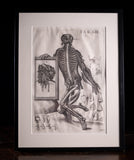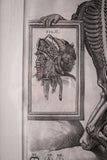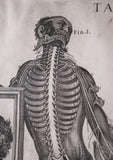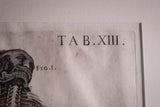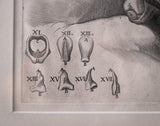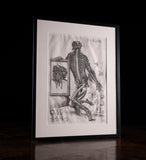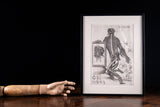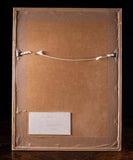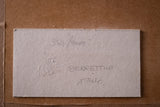A late 20th century engraving of Plate XIII of Pietro Berrettini's Tabulae Anatomicae.
There is some light creasing to the plate but this does not detract from its impact in any way. Housed in a contemporary black frame which remains in a good ocndition throughout. Plaque verso.
Pietro Berrettini's Tabulae Anatomicae
In about 1618, when he was not yet twenty years old, Berrettini prepared a series of twenty anatomical drawings on grey paper, in brown ink and black chalk, washed with blue, sepia and grey, and highlighted with white paint. These drawings may have been made from dissections at the Santo Spirito Hospital, possibly by a virtually unknown surgeon named Nicolas Larchée. Why the drawings were unpublished at the time remains unknown; however, this may have been simply an aborted publishing project in the early career of the artist before he became famous. The drawings dealt chiefly with muscles, nerves and blood vessels, with special emphasis placed on the nerves; nineteen of them depict male figures and one (plate XXVII in the Tabulae anatomicae) a female. Inspired by his era's preoccupation with the "golden age" of classical Greece and Rome, Berrettini made his anatomical figures noble and heroic, placing them in dramatic attitudes amidst columns, plinths and arches derived from classical architecture. "Many of the dissected men hold oval or rectangular medallions-they look like framed mirrors-within which are drawn figures detailing the anatomy of various regions. Others have no accessory figures" (Roberts & Tomlinson, p. 273). Berrettini's original drawings were acquired by Sir William Hamilton, the British Ambassador to the King of Naples, and husband of Admiral Nelson's mistress, Lady Emma Hamilton. In 1772 Hamilton presented them to William Hunter for inclusion in Hunter's anatomical museum. They are now in the Hunterian Collection in the University of Glasgow Library.
In 1741 Gaetano Petrioli, surgeon to Victor Amadeus II of Sardinia, who had also come into possession of the famous Eustachian anatomical plates after their publication in 1714, published Berrettini's plates for the first time. Petroli must have decided to publish the plates because of the high reputation of Berrettini's art in the eighteenth century. Petrioli's edition contained the original twenty plates (nos. I-XIX and XXVII) plus seven others with figures copied from Vesalius, Vesling, Casserio and others, along with commentary supplied by Petrioli. As a supplement, to enhance the unity of Berrettini's plates, Petrioli also had them embellished with numerous smaller anatomical figures taken from Vesalius, Valverde, and others, "engraved in an incongruous manner wherever there was sufficient space on the plate" (Roberts & Tomlinson). Adams P-1925; Choulant-Frank, pp. 235-39; Garrison-Morton 395.2; Heirs of Hippocrates 470; Norman, The Anatomical Plates of Pietro da Cortona (1986) (reproducing four of the original drawings); Roberts & Tomlinson, pp. 272-79; Sappol, Dream Anatomy p.9.
Dimensions (framed)
Height: 52cm
Width: 39.75cm
Depth: 1.5cm
Delivery
UK Mainland: FREE
International Delivery: Please contact us for a shipping quote.










